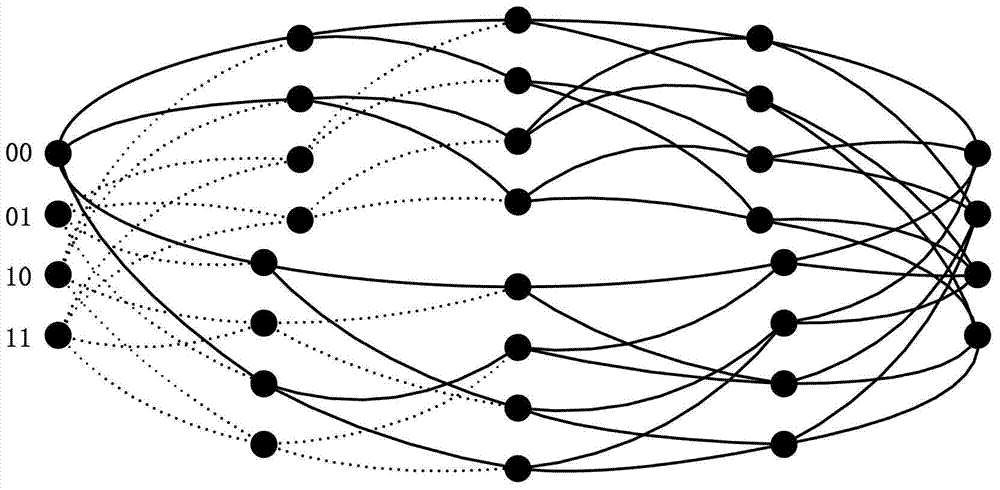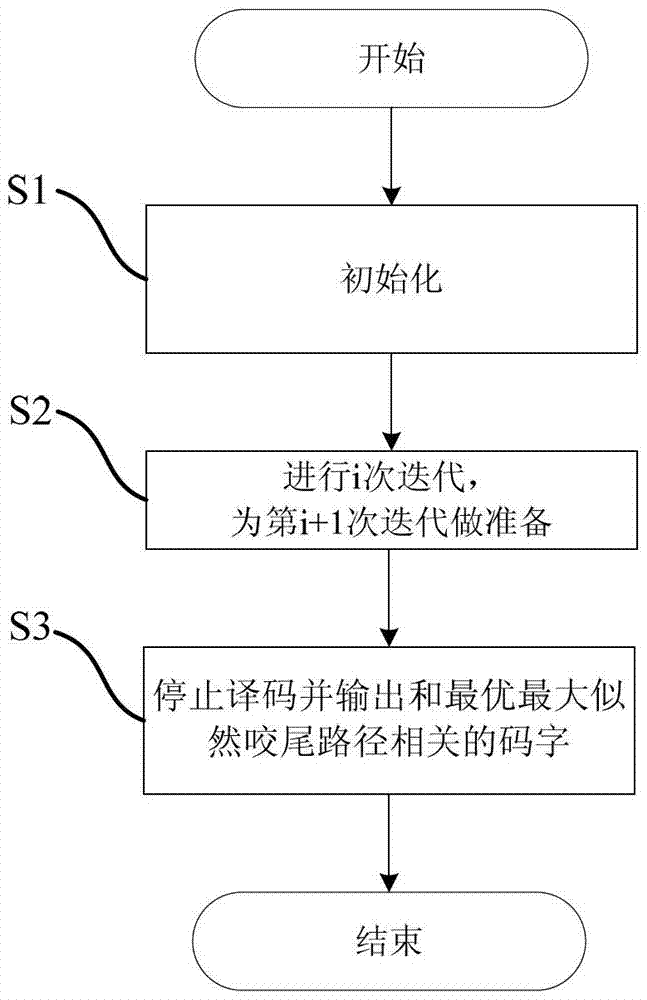A Maximum Likelihood Decoding Algorithm for Tail-biting Codes
A technology of maximum likelihood decoding algorithm, applied in the field of maximum likelihood decoding algorithm of tail-biting code, which can solve the problems of high computational complexity, large memory consumption, and algorithm non-convergence, so as to achieve low complexity and simple decoding. effect achieved
- Summary
- Abstract
- Description
- Claims
- Application Information
AI Technical Summary
Problems solved by technology
Method used
Image
Examples
Embodiment 1
[0064] Applying the maximum likelihood decoding algorithm of the tail-biting code to figure 1 The (8, 4) tail-biting convolutional code for the generator polynomial {7, 5} shown, with figure 1 Take the tail-biting convolutional code represented by the tail-biting grid as an example. In this embodiment, the information sequence is {0, 1, 0, 1, 1, 1, 0, 0}, and the encoded code word sequence is v={(00), (11), (10), (00), (01), (10), (01), (11)}. After the signal-to-noise ratio E b / N 0 After the AWGN channel of =0dB, the receiving sequence r={(1.144,0.458), (-0.986,-1.234), (0.291,1.364), (0.472,0.350), (1.578,-1.594), (0.050, -0.399), (2.260, 0.359), (-1.501, 0.234)}. For clarity, the figure 1 The tail-biting trellis shown in is split from position l=0 as Figure 4 -(a); and the state {00,01,10,11} is expressed as S in octal form 0 = {0, 1, 2, 3}. The decoding process is as Figure 4 As shown, the decoding steps include:
[0065] S1, initialize the surviving state set, ...
Embodiment 2
[0086] The maximum likelihood decoding algorithm of the tail-biting code is applied to the (120, 40) tail-biting convolutional code in LTE, and the generator polynomial of the tail-biting convolutional code is expressed as {133, 171, 165} in octal. The information bit length is 40, which corresponds to the shortest information sequence length of the broadcast channel in LTE. Figure 5 Shows the BFS-ML decoder (Bounded Forward Searching-MLDecoder, BFS-ML decoder, constrained forward search maximum likelihood decoding), TP-ML decoder and BEAST decoder in the tail-biting convolution Code (120, 40) is the storage unit required for the decoding process. It can be seen that the memory required by the maximum likelihood decoding algorithm of the tail-biting code provided by the present invention remains unchanged during the decoding process, and is only 1 / 2-2 of that of the TP-ML decoder and the BEAST decoder. 1 / 3. Image 6 Shows the average number of states visited by the BFS-ML d...
Embodiment 3
[0088] Apply the maximum likelihood decoding algorithm of the tail-biting codes to (24,12) Golay codes, the 64-state time-invariant tail-biting trellis of the Golay codes can be obtained by generating polynomial {103,166}[Stahl99 ] mentioned decoders. [Stahl99] The decoder refers to the paper published by P.Stahl in IEEE Transactions on Information Theory in 1999: P.Stahl, J.B.Anderson, R.Johannesson. "Optimal and near-optimalencoders for short and moderate-length tail-biting trellises”, IEEE Transactions on Information Theory, 1999. Figure 7 Shown are the storage units required by the BFS-ML decoder, TP-ML decoder and BEAST decoder in the process of decoding (24,12) Golay codes. Figure 8 Shown as the average number of states visited by the BFS-ML decoder, TP-ML decoder and BEAST decoder in the process of decoding (24,12) Golay codes. Therefore, the performance of BFS-ML decoder is better than that of TP-ML decoder and BEAST-ML decoder.
[0089] The maximum likelihood dec...
PUM
 Login to View More
Login to View More Abstract
Description
Claims
Application Information
 Login to View More
Login to View More - R&D
- Intellectual Property
- Life Sciences
- Materials
- Tech Scout
- Unparalleled Data Quality
- Higher Quality Content
- 60% Fewer Hallucinations
Browse by: Latest US Patents, China's latest patents, Technical Efficacy Thesaurus, Application Domain, Technology Topic, Popular Technical Reports.
© 2025 PatSnap. All rights reserved.Legal|Privacy policy|Modern Slavery Act Transparency Statement|Sitemap|About US| Contact US: help@patsnap.com



